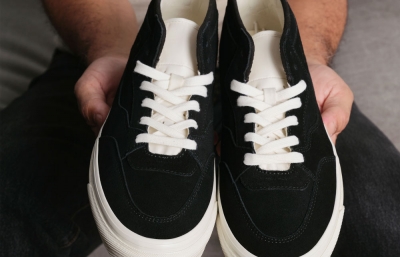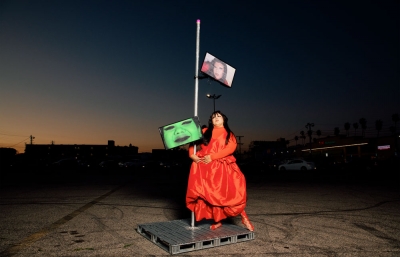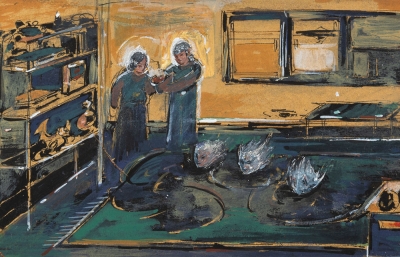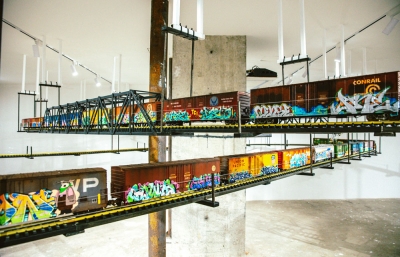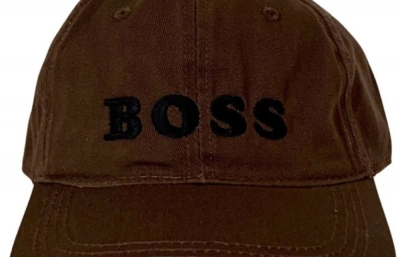Timothy Saccenti’s unique post-production techniques and distinct style have made him a popular choice in the industry for portraits, commercial campaigns, and music videos. Recently, Saccenti has been teaming up with fashion designers, transforming their creations with digital collage, 3D, and other experimental techniques to “create new, unseen realities.”
Photography by Timothy Saccenti, Styling and Costumes by Christian Joy. Digital Sculptural Artist: Sam Rofles. Hair Artist: Yuhi Kim at Bridge Artists using Oribe. Makeup artist: Laura Stiassni at The Wall Group using Dior. Beauty Retouching: Q studios Inc. Models: Hannelore Knuts, Karolina Wallace, and Jules Bakshi.
His latest project is a collaboration with fashion designer, Christian Joy, best known for the costumes she creates for Yeah Yeah Yeahs lead singer Karen O. As artists, Saccenti and Joy’s work incorporates the magical and often unpredictable engagement of another individual. Saccenti’s vision depends on his photographic subject, and Joy’s costumes assume a different life when worn by a performer on stage, not to mention when captured by an experimental photographer. What’s it like being on either side of the collaborative table? Saccenti and Joy sat down to talk it out. —Alex Nicholson
Timothy Saccenti: As we both collaborate often with musicians, how do you feel working with artists, and does music affect your process?
Christian Joy: There's so much that goes into the process. I have to think about their own personal style, as well as what the music is like and how they move on stage. I also need to think about the size of the venue and the audience.
TS: Interesting. I only see the surface, what will work in two to three dimensions with reflected light. Just a few moments in front of the camera or scanner means a very different approach. Do you have a manifesto to your work in general?
CJ: I like to keep it pretty bold and optimistic. More than anything, I want my work to make people feel happy and excited.
TS: Some of these outfits seem Kabuki in nature. Is that a source of inspiration? Well, Kabuki meets Bowie meets Fraggle Rock in space...
CJ: Oh, definitely. I love the colors and patterns of Kabuki, as well as the hair and makeup and definitely Bowie. He's been an inspiration from the beginning of my career. How did you decide to photograph and manipulate my work?
TS: First, as I do for most things, I really looked at the clothing, the patterns, the DNA of it, so to speak, and the character of the people who would wear it. You work with such strong women and artists, and I wanted that to be a part of it, as well as the humor, texture and color. It’s often impossible to know what will come out, so in the space, I felt some kind of alchemy with the people, the clothing, music, and light. In post production, we were trying a new technique that would take the strong patterns and stretch and manipulate them in space. It’s a variation of a device called the Rutt/Etra, a 1970s era visual synthesizer. I treat the studio as an experimental tool to explore possibilities, rather than an area to record a reality. Do you have a place in your process for this experimentation?
CJ: I think the stage is it for me. I need to know how the audience will react, so when I have someone who's open to experimentation like Karen O, it's really important. Although, now that I say that, because I don't often work in the studio, I do see the endless possibilities. Hannelore Knuts is a good friend and incredible model. She always opens my eyes to the possibilities of each look, especially because I'm used to seeing things as one outfit. There was a moment on set where she put together a kimono and bodysuit that I thought would never work, and she started kicking her leg and totally turned it into something else. I can never seem to remember that when it's on set, you can do things in a way that you're unable to do live. Looking at your Instagram really opened my eyes to the endless possibilities that could be created on set. How did you get into creating 3D images? I feel like it must take a very particular team to understand your vision.
TS: As someone who was interested in photography, but not at all bound by its “duty to show the truth,” I’m always trying to incorporate new approaches and ways of seeing. In the past, we’ve used 3D extensively to create reality-based elements that were impossible to shoot and then incorporated them into photographs. The current approach we have is to use the 3D and Photogrammetry to create new, unseen realities, rather than replicate the current one. Recently, I’ve been collaborating with the artist Sam Rolfes. The approach we have, I hope, utilizes the amazing texture and light transforming elements of photography with the spatial and time dilating possibilities of 3D.
CJ: Where does your inspiration for this approach to photography come from? Who are your idols?

TS: With the Internet, I think the idea that your idols and inspirations are some far off, mysterious and obscure entity has changed. There’s so much amazing work being created now, it’s hard to keep up. Generally speaking, my inspiration is the people I’m working with at the time. For this collection, it’s you and your world view, and Sam and his world. But I do think it’s a rich time. There have been some amazing new voices. Being in NYC, you can just walk down the street and be exposed to artists you’d never knowingly find. Bold patterns and color play heavily in your work. How do you come up with them?
CJ: I do a lot of research, but I think a lot of what I'm inspired by comes from random interactions and things I see on the street. I try to plant little trees in my brain. I also write ideas down or take a photo, but I don't often look back on those, so it's more that I want to get the idea into my brain and let it float around and interact with whatever is already happening in there.
TS: It feels like there’s an inherently strong feminist element to your work and designs. Is this conscious on your part or built into the DNA of your process?
CJ: I think it's just part of my DNA! I grew up with four brothers and born again Christian, so my parents really wanted me to act like a girl. I was raised to get married and have babies and be submissive to my husband which, naturally, I rebelled against. I could never understand why I couldn't act and dress like my brothers.
TS: There’s an unmatchable youthful element as well. When you were young, did you make outfits for yourself? What is the first piece you remember creating?
CJ: I think a lot of it comes from growing up with very limited resources. My grandma would give me $20 and I would try to stretch it as far as I could to buy cool clothes. I was also really into MTV and pop music. This was during the ’80s, so it's right when MTV came out. My parents wouldn't allow me to listen to rock music so I wanted to even more. I remember going to Kmart and buying these multi-toned stone-washed jeans with a red ribbed rubber belt and telling everyone that it was my Michael Jackson belt.

TS: Our pre-shoot conversation inspiration included microbes, Tardigrades (the indestructible-but-adorable space-dwelling water bears), electron microscope photography, classic Issey Miyake pieces photographed by Irving Penn, Tadanori Yokoo, mushrooms, fungus and the energy of our models Hannelore Knuts and Karolina Wallace. How do you think these influences translated to the final images?
CJ: With what I've seen, it seems to have transcended my expectations!
TS: On set, how did you feel seeing our photographs transforming your designs?
CJ: I'm really pretty open to letting other artists translate my pieces in the way they want. I don't try to control the situation. I learned right off the bat to just let it go when I saw Karen O pouring beer all over her looks. I was really excited to work with you because sometimes I feel like my work gets stuck in one particular reality. I feel more grounded to the earth, but your reality seems like it's somewhere inside The Matrix. Can you elaborate on what brought you into this direction?
TS: Each project starts from scratch. How do we express this music or person’s world visually? From there, we collect colors and shapes, abstractions and themes and use those elements to create a world. My interest in science, philosophy and the origins of consciousness has driven it in a certain direction as well. I spent my formative years in dark clubs exposing my brain to these frequencies and synapse-altering experiences, mixed with this near-cybernetic connection to technology, so it all adds up to this aesthetic output. On the surface, our works are quite opposite, mine having an austere, baroque futurism at times, and yours being full of color, youthful energy and life. How do you feel this translated in the imagery? I think we both have humor as a common element in our works, though sometimes it’s hidden.
CJ: Yes, I definitely agree with that. I remember seeing a video you did of an alien and girl in love and being totally blown away. It was so hilarious!
TS: Both of our works seem to eschew reality, as if we are plucking things fully formed from an alternate dimension. Is there a process you use to glimpse this world that you are pulling from?
CJ: The other day in yoga class, I was in pigeon pose and my eye was pressing against my arm, and I was getting this crazy glowing colorful leaf-like shape in my head, and I just kept trying to get the colors to change. I was thinking about the third eye. I try to be open to other realities. I like feeling like there is some scary, strange open door that I can walk through when I want.
TS: What shall we create together next? I’ve always wanted to create a kind of art therapy program.
CJ: That sounds good to me! I love teaching.
----
Originally published in the June 2017 issue of Juxtapoz Magazine, on newsstands worldwide and in our web store.
















